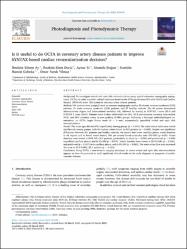Is it useful to do OCTA in coronary artery disease patients to improve SYNTAX-based cardiac revascularization decision?

View/
Access
info:eu-repo/semantics/embargoedAccessDate
2023Author
Ay, İbrahim EthemDural, İbrahim Etem
Er, Aynur
Doğan, Mustafa
Göbeka, Hamidu Hamisu
Yılmaz, Ömer Faruk
Metadata
Show full item recordCitation
Ay, İ. E., Dural, İ. E., Aynur, E. R., Doğan, M., Gobeka, H. H., & Yilmaz, Ö. F. (2023). Is it useful to do OCTA in coronary artery disease patients to improve SYNTAX-based cardiac revascularization decision?. Photodiagnosis and Photodynamic Therapy, 103540.Abstract
Background: To investigate retinal and optic disk microcirculation using optical coherence tomography angiography (OCTA) in order to predict related outcomes based on the SYNergy between PCI with TAXUS and Cardiac Surgery (SYNTAX) score (SS) system in coronary artery disease patients.
Methods: 104 patients were grouped based on coronary angiography results: 32 chronic coronary syndrome (CCS) patients, 35 acute coronary syndrome (ACS) patients, and 37 healthy controls. The SS system determined atherosclerosis degree and lesion-related mortality risk, followed by scoring as SYNTAX I score (SS-I) and SYNTAX II score (SS-II). Patients were further subdivided into SS-I, SS-II percutaneous coronary intervention (PCI), and SS-II coronary artery by-pass grafting (CABG) groups. Following a thorough ophthalmological examination, an OCTA Angio Retina mode (6 × 6 mm) automatically quantified retinal and optic disk microcirculation.
Results: The mean ages did not differ significantly among groups (p = 0.940). The outer retinal select area varied significantly among groups, with the highest values found in ACS patients (p = 0.040). Despite non-significant differences between SS-I patients and healthy controls, the former had lower capillary plexus vessel densities in all regions and in foveal vessel density 300 μm around foveal avascular zone (FD-300) (p>0.05). Vessel densities were lowest in SS-II PCI≥28.5 patients, particularly in whole (p = 0.034) and parafoveal (p = 0.009) superficial capillary plexus, and in FD-300 (p = 0.019). Vessel densities were lowest in SS-II CABG (p = 0.020), and perifoveal (p = 0.017) deep capillary plexus, and in FD-300 (p = 0.003). The outer retina flow area increased the most in SS-II CABG≥25.1 patients (p = 0.020).
Conclusions: Using OCTA, a non-invasive imaging technique, to assess retinal and optic disk microcirculation appears to have the potential to yield significant clinical results in the early diagnosis or prognosis of cardiovascular diseases.















